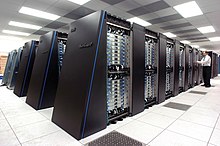https://liliputing.com/2019/03/google-stadia-is-a-game-streaming-service-for-...  Background (a little bit of background anyway)
Background (a little bit of background anyway)Intel has been bending PC benchmarks all over the place to remain the"King of Gaming" as if local PC gaming is the proper expression of the "ultimate in computer performance". Intel has also just spent a mort of money to try to upgrade their built in Intel video systems to get somewhere closer to Nvidia and AMD's top end graphics card output levels (not yet done, not yet tested, certainly not shipping yet).
Folks have been waiting for a series of Fat Ladies to come sing for Intel as they are doomed by their lack of technological progress, doomed to fall from their lofty top market position ---- and the fall for Intel is a very steep
very deep one if it takes place at this point in Intel's history.
Google had already dumped Intel servers off their data farms for Tensor Processors, a Google invention that puts more speed and computing power on a single rack card than used to run on an entire room sized Intel based Supercomputer.
 https://www.extremetech.com/computing/263751-googles-ai-cloud-tensor-processi...
https://www.extremetech.com/computing/263751-googles-ai-cloud-tensor-processi...This stuff PER CARD is more powerful than 2005's original Blue Gene complex at the US Federal Research Facility Lawrence Livermore National Laboratory
That is per card, mind you. One (1) Tensor Quad Stack card > original Blue Gene Complex in gigaflops/second.

At 180 gigaflops of super fast compute power
per card, what in the world was Google planning to do to exercise all that computing power that would reside in the very first rack wall in the very first Google Tensor Farm?
Google needed something to do with all that excess compute power ......Answer, sell the computing services that normal people want at a much reduced cost. Google has a HUGE surplus in computing power compared to the world's total computing workload right now, so what are they going to do with it to make it useful to humanity?
START WITH GAMES AND GAMING, Google is going to run Crysis for you (and any other game you want to run) on any device that will hook up at 60 frames per second full speed to a 4G or 5G cellular network (or to just about any fiber optic LAN Wifi system).

Have some modern high speed Wifi in your house and now you can go buy a new Google Wifi game controller (it attaches DIRECTLY to the web at your router and again directly to your Chromecast dongle equipped TV and again simultaneously to Google's server farms through the internet, it does not go through your pokey PC or phone hardware ---
nothing goes through your old slow equipment except to simply display the video graphics stream that is going to be sent to your device in response to your controller movements).
Pay the monthly bill and you can game ANYTHING until your fingers fall off. Anywhere there is good enough Wifi to attach to Google and that will support the 1080p 60 frames per second minimum data stream. No super strong home computer is required any more. Sit in the park, use your relatively new cell phone, Google doesn't care.
Game on .... Game on .... Take a break and watch a movie for a bit, it is all the same data feed stream as far as Google sees or cares.
Google, AMD, Gabe at Steam are all kicking in on the details to make up a workable system, one that removes the need for Intel super duper expensive Core i7and i9 processors completely.
AMD is the preferred silicon processor vendor, because they make modern lithography combined APU chipsets with appropriate fast memory and state of the art graphics and AMD is well accustomed to the gaming environment. Plus, Gabe likes them because of the open source video driver sets and WIDE support thereof. Gabe sees AMD as a kindred soul.
Intel is NOT part of this open source based consortium and Intel really cannot compete against it from here forward ......
The Fat Lady has started singing the very first full aria in the Intel Swan Song.
Intel may be the current King of PC Gaming, but
of what real value is that after today ???

==================================================
AddendumThe Chromebook folks have asked their question and gotten their answer ---- ANY Chromebook that is still getting updates is going to get this ability in 3-4 weeks to use Stadia Game Streaming.
Chromecast dongles, Chromebooks, Chromeboxes and standard Android devices will also be able to hook Stadia up to your TV. There is an attached movie service, too.
Your oldest moldiest PC using appropriate modern fast connect Wifi speeds and a decent video system will be able to do the same, as shown by the months long Stadia demo that Google did late last year.
https://youtu.be/4SOS-a4ks7s This is the official Stadia pre-launch presentation in 10 minutes or less.
Folks, this may be kinda large, really.
Barrons is running it as breaking financial news that is pro AMD and pro Google and signals a stock price jump for both companies.The sound of the Fat Lady singing Intel's Swan Song is getting louder and louder day by day by day.

